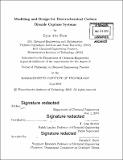Modeling and design for electrochemical carbon dioxide capture systems
Author(s)
Shaw, Ryan Alex.
Download1121594801-MIT.pdf (17.88Mb)
Other Contributors
Massachusetts Institute of Technology. Department of Chemical Engineering.
Advisor
T. Alan Hatton.
Terms of use
Metadata
Show full item recordAbstract
So long as fossil fuels remain humanity's primary source of energy, carbon dioxide capture and storage will be needed to mitigate the effects of global climate change. Existing carbon dioxide separation technology is energetically intensive and expensive to employ in brownfield applications. This thesis describes a novel CO₂ capture technology called Electrochemically-Mediated Amine Recovery (EMAR). EMAR modifies incumbent thermal amine scrubbing, by performing an electrochemical desorption which manipulates the concentration of a cupric competitive complexing agent. Oxidizing copper results in a cupric-amine complex at the anode, releasing CO₂. Reducing this complex at the cathode regenerates amines for capture. This approach is more energy efficient than traditional thermal amine processes and is expected to be less capital intensive to implement. A proof-of-concept EMAR system has been previously demonstrated and initial system optimization has been previously performed. Contained herein is a significant expansion of that work specifically in the areas of thermodynamics, mass and heat transport, and system design. Three thermodynamic paths are described for the EMAR process, which establish the total electrochemical work of separation for this and other similar molecular architectures. Electrochemical work, in concert with work of compression and pump work, allow for an ideal process flow scheme as well as optimized operating conditions for the EMAR process to be developed. The thermodynamics suggests employing a cathodic absorber for substantial efficiency improvements. EMAR cell design is significantly improved by transitioning from a single unit cell to a modular, stacked system. Performance of two stack geometries, series and parallel, is modelled and analyzed. It is demonstrated that the series stack, which is more industrially applicable, shows less severe internal temperature gradients than that of the parallel geometry.
Description
Thesis: Ph. D. in Chemical Engineering Practice, Massachusetts Institute of Technology, Department of Chemical Engineering, 2019 Cataloged from PDF version of thesis. Includes bibliographical references (pages 185-190).
Date issued
2019Department
Massachusetts Institute of Technology. Department of Chemical EngineeringPublisher
Massachusetts Institute of Technology
Keywords
Chemical Engineering.